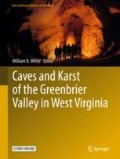Abstract
Every cave has the potential to be a repository of Pleistocene and older bones and past life. The Greenbrier Valley Karst in particular has a rich repository of late Pleistocene faunal remains. Cave entrances lend themselves to be nesting places for birds of prey who deposit the bones of their meals onto cave floors. The very nature of sinkholes and surface pits creates natural traps for animals. Streams are a source for depositing animals in caves where they die and are buried in cave sediments. Caves are also used as dens for a variety of extinct and living animals that died or left the remains of their prey. The unique environment of caves contributes to the entrapment and preservation of Ice Age bones.
Access this chapter
Tax calculation will be finalised at checkout
Purchases are for personal use only
References
Barr, T.C., Jr. 1953. Fossil vertebrate remains from Laurel Creek Cave. N.S.S. News 11 (6): 2.
Gidley, J.W. 1918. A Pleistocene cave deposit of Western Maryland. Smithsonian Institution Annual Report 281–288.
Grady, F. 1988a. Fossil vertebrates. In Caves of the Organ Cave Plateau, ed. P. Stevens, vol. 9, 51–55. West Virginia Speleological Survey Bulletin.
Grady, F. 1988b. A preliminary account of the Pleistocene mammals from Patton Cave, Monroe County, West Virginia. National Speleological Society Bulletin 50 (1): 9–16.
Grady, F., and R. Garton. 1994. The Pleistocene peccaries Platygonus vetus and Platygonus compressus from West Virginia caves. Proceedings of the West Virginia Academy of Science 66 (1): 52.
Grady, F., J. Arroyo-Cabrales, and E.R. Garton. 2002. The northernmost occurrence of the Pleistocene vampire bat Desmodus stocki Jones (Chiroptera: Phyllostomatidae: Desmodontinae) in eastern North America. Smithsonian Contributions to Paleobiology 93: 73–75.
Guilday, J.E., and A. McCrady. 1966. Armadillo remains from Tennessee and West Virginia caves. National Speleological Society Bulletin 28 (4): 183–184.
Handley Jr., C.O. 1956. Bones of mammals from West Virginia caves. American Midland Naturalist 56 (1): 250–256.
Jefferson, T. 1799. A memoir on the discovery of certain bones of a quadruped of the clawed kind in the western parts of Virginia. American Philosophical Society Transactions 4: 246–260.
Mercer, H.C. 1897. The finding of remains of the fossil sloth at Big Bone Cave, Tennessee in 1896. American Philosophical Society Transactions 36 (154): 36–70.
Shockey, R. 1968. Remains of giant bear found in Grapevine. Baltimore Grotto News 9 (12): 317–342.
Stafford R. 1961. Bones in a cave. N.S.S. News 19(7): 80.
Wistar, C. 1799. A description of the bones deposited by the President in the Museum of the Society. American Philosophical Society Transactions 4: 526–531.
Author information
Authors and Affiliations
Corresponding author
Editor information
Editors and Affiliations
Rights and permissions
Copyright information
© 2018 Springer International Publishing AG
About this chapter
Cite this chapter
Garton, E.R., Grady, F.V. (2018). Pleistocene Vertebrates from Greenbrier Valley Caves. In: White, W. (eds) Caves and Karst of the Greenbrier Valley in West Virginia. Cave and Karst Systems of the World. Springer, Cham. https://doi.org/10.1007/978-3-319-65801-8_20
Download citation
DOI: https://doi.org/10.1007/978-3-319-65801-8_20
Published:
Publisher Name: Springer, Cham
Print ISBN: 978-3-319-65800-1
Online ISBN: 978-3-319-65801-8
eBook Packages: Earth and Environmental ScienceEarth and Environmental Science (R0)

